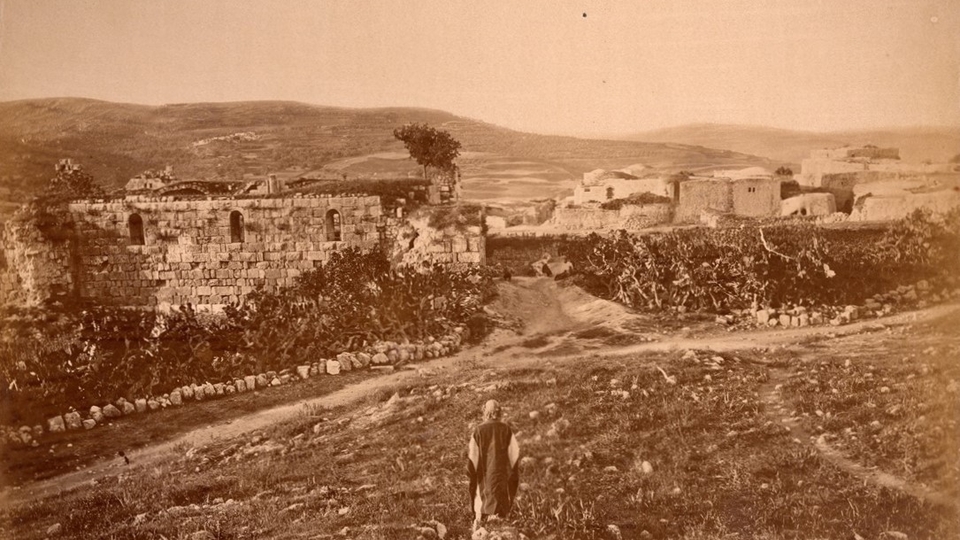Against Genocide: Mapping the Future of Palestine, One Archive at a Time
Editor's Note: This is the first edition of "The Transcripts," a newly launched section featuring a record of interviews, conversations, or lectures we believe matter to making sense of the world we live in, help cultivate various forms of resistance to the dominant order, and imagine alternative ways of seeing and being. Contact us if you would like us to feature a talk you've organized; we welcome submissions from around the world so long as they serve the public interest and advance our movements for social and economic justice. These transcripts are edited for length, clarity, accuracy, and grammar.
Renowned scholar and historian, Dr. Salman Abu Sitta, founder and President of the Palestine Land Studies Society in London and donor of the Palestine Land Studies Center (PLSC) in conversation with Ghada Dimashk, PLSC coordinator, librarian and archivist, for the first installment of Archives & Heritage for Palestine, a series hosted by Dr. Jamila Ghaddar and Tam Rayan, in defense of Palestinian life, land, liberation, and return at the American University of Beirut on June 4, 2024.
Drawing on records, documents, and maps from the PLSC collection, Dr. Salman Abu Sitta illustrates and explores the role of archives and heritage pertaining to Palestinian history and identity to counter epistemic violence, colonial erasure, and the cultural dimensions of genocide.
The following individuals gave introductory remarks before the talk: Ghada Dimashk, PLSC coordinator, librarian and archivist; Dr. Jamila Ghaddar, assistant professor, Department of Information Science, Dalhousie University in Canada and director, Archives & Digital Media Lab; Rami Zurayk, professor and chairperson, Department of Landscape Design and Ecosystem Management, Faculty of Agricultural and Food Sciences, American University of Beirut and interim director of the PLSC; Fatme Charafeddine, associate university librarian for Research and Academic Collaboration Services at the American University of Beirut; Basma Chebani, president, Lebanese Library Association; Dr. Fadlo Khuri, president, American University of Beirut; Dr. James Lowry, founder and director of the Archival Technologies Lab at City University of New York.
Dr. Salman Abu Sitta, founder and president of the Palestine Land Studies Society in London:
It's very important that we know all the facts. The facts set us free. The facts help us make the right decisions. Also, the truth is the basis of justice, [so] we must always seek the truth. The enemies of truth do not seek justice. And I always ask: who is afraid of the truth? Only the criminal is afraid of the truth. Only the criminal wants to hide that. And in my case, as any Palestinian who witnessed Al Nakba on this fateful day of 13th of May 1948, we were attacked by 24 armored vehicles in my land Al Ma’in by the Haganah. And they attacked us. They destroyed the school which my father built in 1920. They destroyed our houses. They destroyed the wells and the flour mill. They destroyed everything. They burnt everything and they killed everyone in sight. And I was, as a child of 10, amazed. Who are these people? Where do they come from? The elders told me they come from different countries. They call them Vagabonds of the Earth, because they came from so many countries, they spoke different languages. I said, what have we done to them? Why did they come to us to destroy our life, to destroy our houses, to destroy everything which brings life to us? Where we have lived for thousands of years? And this question has grabbed my attention all my life. Who are these people? Why do they want to do that? When we were expelled on that day, I became a refugee, on the 14th of May 1948.
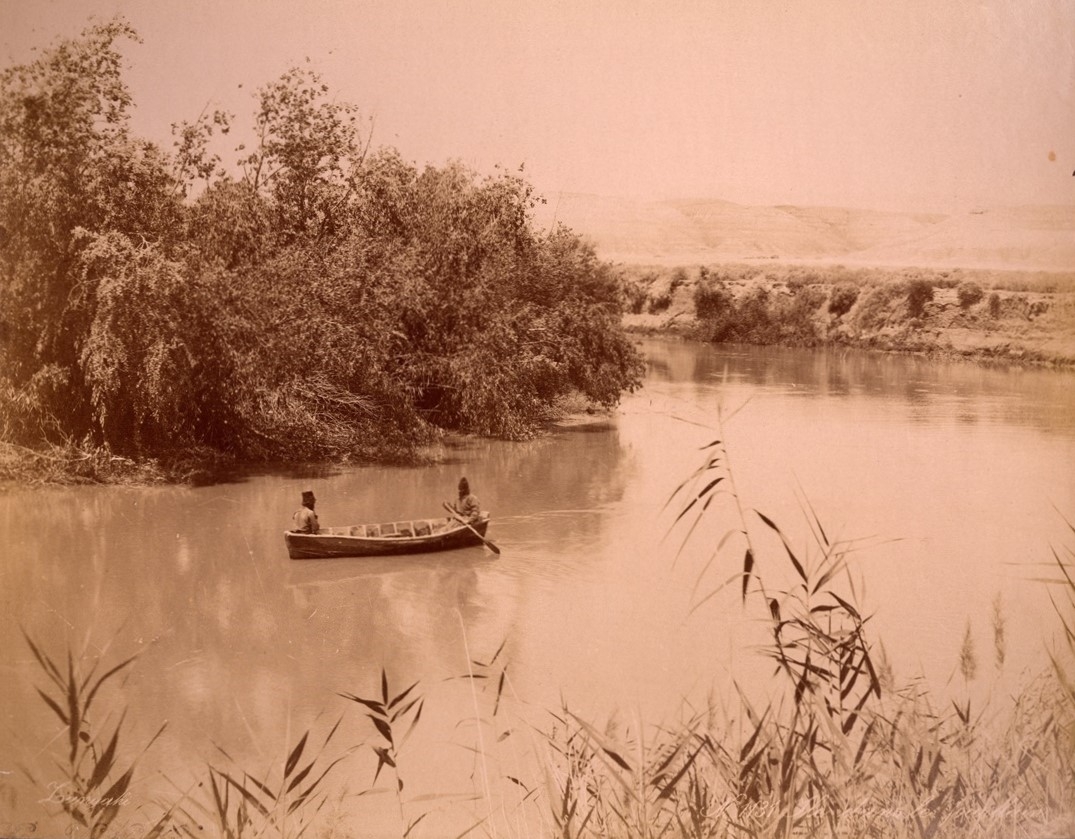
An island in the Jordan River. E. W. Blatchford Collection, 1880-1900, American University of Beirut, Library Archives.
On the very same day, when I became a refugee, after the destruction of our home, a man called David Ben Gurion sat in Tel Aviv, spoke to his council of settlers in our land, and declared the State of Israel for the very same reason. Then, fortune took me to all corners of the earth after that. And this question remained in my mind all my life until today. One thing we must remember is that not only have we lost our own homes, like all Palestinians, not only have we lost our land, we also lost our identity as a legal identity. We lost every record of the Palestine government, we lost certificates of birth and death, school certificates, medical certificates, banks, records of harbors and ports, records of ownership of land, we lost every single trace, to unite our geography and history. But we have one thing left in our mind. Until today, we had the memory and the identity. So our job in life, for all of us, is to bring documents to prove that we have been there. This is our country. This is our life. The robbery which has taken place is not only [found] in the physical features but also in the indirect features of our life, our geography. Our existence has been denied. Their history says that Palestine is a land without people. All this is unbelievable. There is no case in history like it, neither in colonization, nor in occupation. So the question, which occupied my attention, especially when I did my PhD in London in 1961, is to go to the records of the British government, because 10 years earlier, they had just left Palestine. So this was a natural thing to do.
We lost every record of the Palestine government, we lost certificates of birth and death, school certificates, medical certificates, banks, records of harbors and ports, records of ownership of land, we lost every single trace, to unite our geography and history
Over the years, I found a very curious situation that we in Palestine, and also in Bilad al-Sham including Egypt, did not bother to document our existence, because we didn't need to. We had families, we had grandfathers, grandparents and so on. We know who we are, we know where we live, we don't need a piece of paper to prove that we belong to this land. And where did I find these documents? These documents were found in the colonization records of the countries which came to colonize us, the records of our mapping. Our records were found in London, in Berlin, in other places, because they had their plans to take over our land from Napoleon since 1801, when he came to Palestine and Egypt. They had an army of travelers, spies, priests, travelers, adventurers, surveyors, etc. They came to write the documents by all kinds of means, so it was more than natural for me to seek [out] these records, which we have been denied to have in these countries. And it took, of course, many years to do that.
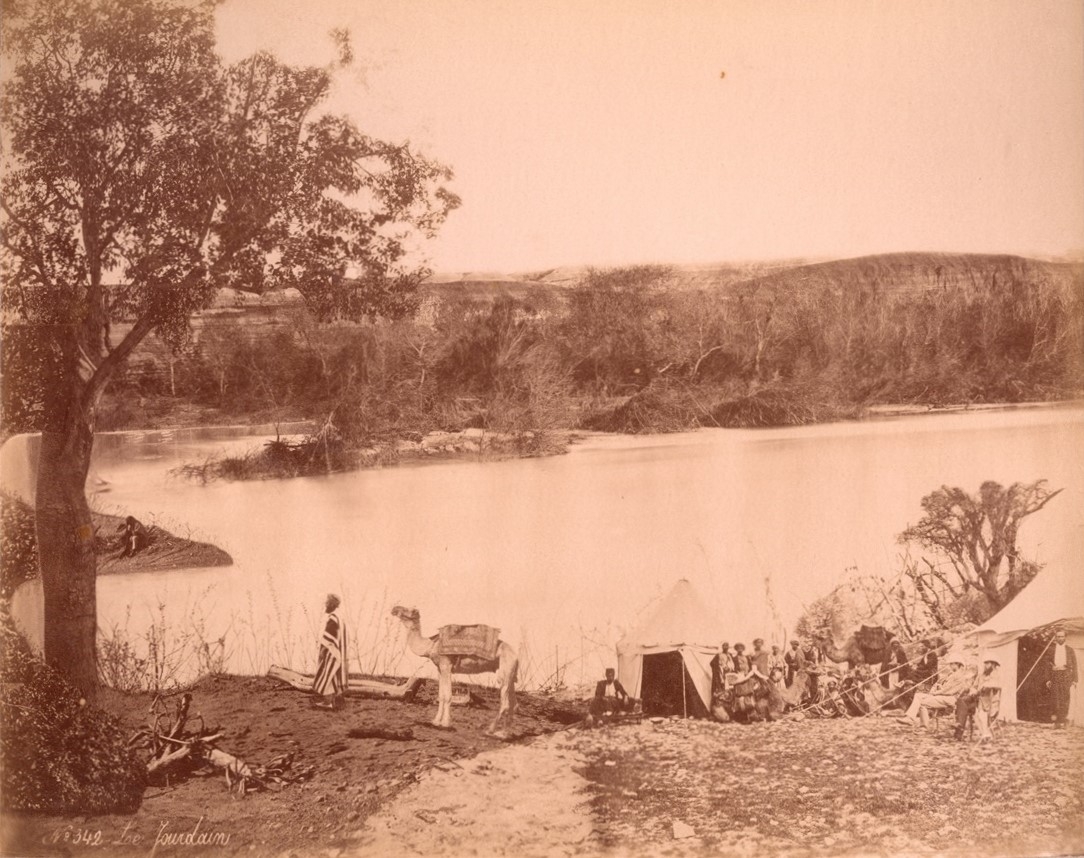
The Jordan River. E. W. Blatchford Collection, 1880-1900, American University of Beirut, Library Archives.
In Britain, for example, there were 20 to 30 places where you could find these in military archives or political archives. This is only the case for Palestine, not any other colonized land. But then you go to Germany, for example, which had been fighting the first World War with the Turks. Here I found the first aerial photos of the German Air Force in Palestine. You could go further, to Napoleon’s time, when he had 76 scientists come to Palestine and Egypt and record our countries. Before them, Volney came in 1785. He made maps of Bilad al-Sham. But when we go to recent times, you would like to find out what Balfour did and why. You will know that the first British High Commissioner Herbert Samuel was a Zionist. You will know what happened in 1936 to 1939, when there was a big revolt against the emigration of Ashkenazi Jews to Palestine, and all the records are in the military archives of King's College. You then see how, after the 1939 revolt, the Zionists were sure that they would capture all of Palestine. So they started planning to invade and take Palestine in 1942, at The Biltmore Conference, in which 600 Zionist delegates and leaders met to create the Jewish Commonwealth in Palestine, while the British were there.
In 1945, when the British began to think of leaving, the Zionists attacked them. They attacked their erstwhile benefactors because they didn't need them anymore. And then we find in 1948, all the records of the over 90 massacres committed by Zionists against Palestinians, in which they attacked and depopulated 530 towns and villages and deported and expelled them through the threat of massacres. When you check all these massacres, they were planned by region, by time, in nine brigades attacking these villages. That was a deliberate plan to expel Palestinians: we kill many of you, and if the rest don't leave, we'll kill you. So the answer is very clear: ethnic cleansing. And when you actually look at that, the records are fantastic because you read them with a new look. For example, you will know the myth that Palestine is a land without people, which was propagated in the 19th century, turned out to not really be a myth. They knew that Palestine was populated. There was a plan to make it a land without people. So the genocide idea was created very early on, that the Zionists would like to make a Palestine without people. And that's the definition of genocide.
The myth that Palestine is a land without people, which was propagated in the 19th century, turned out to not really be a myth. They knew that Palestine was populated. There was a plan to make it a land without people. So the genocide idea was created very early on, that the Zionists would like to make a Palestine without people. And that's the definition of genocide.
While the British were in Palestine in 1940, Joseph Weitz, who was the head of the [Jewish] Colonization Department, the Jewish National Fund, said: “We shall not leave one village alone, we should not leave that.” That was in 1940. In the United Nations library, you’ll find very important documentation about the massacres written by Truce Observers, who were primarily European UN officers. They documented massacres at that time, and they said, sorry, we have no time to document all massacres because there are so many. These records of the United Nations Truth Observers are not known to the public. They are hidden. In another example, the Quakers were the first Christian group to come to Palestine. They are actually the ones who were based in the refugee camps in Gaza and said these people, the Palestinians, don't want food, they only want to return home.
When you look at the series of actions by Israel after 1948, they did what we call today ethnic cleansing. What does it mean? Ethnic cleansing means I take your land and property and throw you out. If you don't go, I will kill many of you to convince you to leave. Fine. Well, that has happened in many countries before. What is different in this case is that these Palestinians who were expelled have been chased by the Israelis, even in their refugee camps. For example, one of the big massacres was the Khan Younis massacre in 1956, during which every house lost one young man, taken out of his home and killed. There are so many cases. So what is happening in this question of ethnic cleansing is that, over time, it converted into genocide. That is the case today in Gaza because these people [the refugees] will not go away. “We have to take their country. We have to kill them, but they keep coming back. We will chase them.” Why did they, for example, make massacres in Sabra and Shatila and in Jenin? If you look at the news today, you see all the attacks against refugee camps: in Jenin, in Balata, in Nablus, in Tulkarem. They will chase the very same people whom they have tried to expel. Now, therefore, documentation is the proof, not to us, but to the world who supported [the Zionists]. We take the records from the West and tell the West, again: look, your records show what I told you all the time, you didn't believe me. Now you have that record and, therefore, you have no excuse. If you ignore the truth, then you are on the side of the criminal. And that is the reason we created these archives and this center.
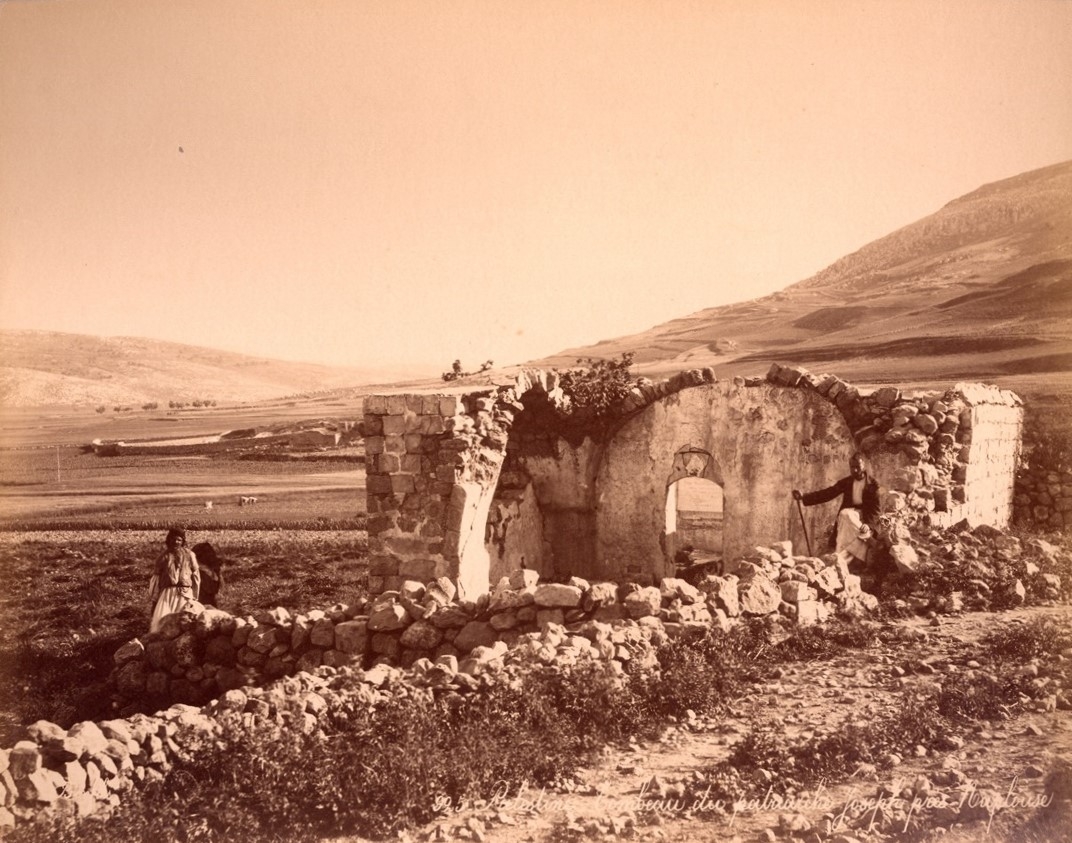
The tomb of Patriarch Joseph near Nablus, West Bank, Palestine. E. W. Blatchford Collection, 1880-1900, American University of Beirut, Library Archives.
Dr. Jamila Ghaddar: There is no doubt that the archives of the Western powers are full of records and evidence of colonial crimes all over the world. But something different happens when we get our hands on them. They don't just sit there, hidden in basements, doing nothing. They actually can be connected to the people they're about for the ends you're talking about. So thank you for doing that remarkable work.
Ghada Dimashk: First, Dr. Salman, I'm so proud and honored that I had the chance to learn more about, to document, and to archive the Palestinian case through your collection. And I can say that I have learned a lot from you in this matter. During my cataloging and archiving, I kept asking myself: you are an engineer, so how come you decided to go and start collecting archives? Is it because of, as you said, the struggle against your identity and the erasure of your identity? How did you deal with the erasure of your identity? You faced this many times in London. When they issued a card for you, there was the nationality part where they wrote “uncertain”. You had asked for a map of Palestine and they said they don't know what Palestine is, and many more incidents. My second question is, have you ever encountered obstacles in reaching a Palestinian archive in the West?
“We take the records from the West and tell the West, again: look, your records show what I told you all the time, you didn't believe me. Now you have that record and, therefore, you have no excuse. If you ignore the truth, then you are on the side of the criminal. And that is the reason we created these archives and this center.”
Dr. Salman Abu Sitta: I repeat this story all the time because it touches my heart. I was doing my PhD at University College London from 1961 to 1964. And, at the time, we were given a card called the ‘Alien Card’ to allow us to stay. So, one day, I went to the home office to renew my card. I renewed it and looked at it after I left. Next to nationality, it said “uncertain”. So I went back to the desk, and said to the officer: “What do you mean? I am Palestinian, my father's Palestinian, you know that, you are forty years old, you must have served in the Palestinian government ten years back!” He looked at me and said, “Sorry, young man, sorry. It's only a formality.” “I am uncertain, by whom?” I asked. “By Britain, which made [The] Balfour [Declaration].” So, that was of course, a big shock. But that did not deter me because the search for this was, to me, a lifeline. What do we collect all that data for? Just for history books? No, we must make it the foundation for the future. So why did people in the colonial West send emissaries and surveyors as a prelude to occupy our country? So if I have this data, then I should be able to try to recover my country. Not to me only, but to all the others.
We now have new methods to accumulate this data, like GIS and statistics and all that, which is a great effort. I wanted to focus on two things – land and people. [The] land is Palestine and we are the people. The element of land was necessary to know about the land we lost. So we did a lot of studies over time. We created the Atlas of Palestine 1917 to 1966 because it is the period which includes the Mandate, the Nakba, and thereafter. I said 1966 because I wanted to avoid 1967. In 2010, the atlas appeared in many Israeli universities and not one of them asked any questions about its accuracy. This [Israeli] historian Benny Morris wrote three reviews of the atlas and in the end he said that the author wants to reconstruct Palestine. Thank you very much. Yes, this is what I wanted. So he could not say “this is wrong” or “this is right”. That's why it was translated into Arabic, Spanish, and recently into Russian. We have another version of the atlas. It's called Atlas of Palestine 1871-1877, which to me is very important because it really relates to Palestine before 1900, when there was no Zionist colony in Palestine. There were [the] first Jews in Al Quds as people, but there is not a [Jewish] plot of land. This is important because it shows the land.
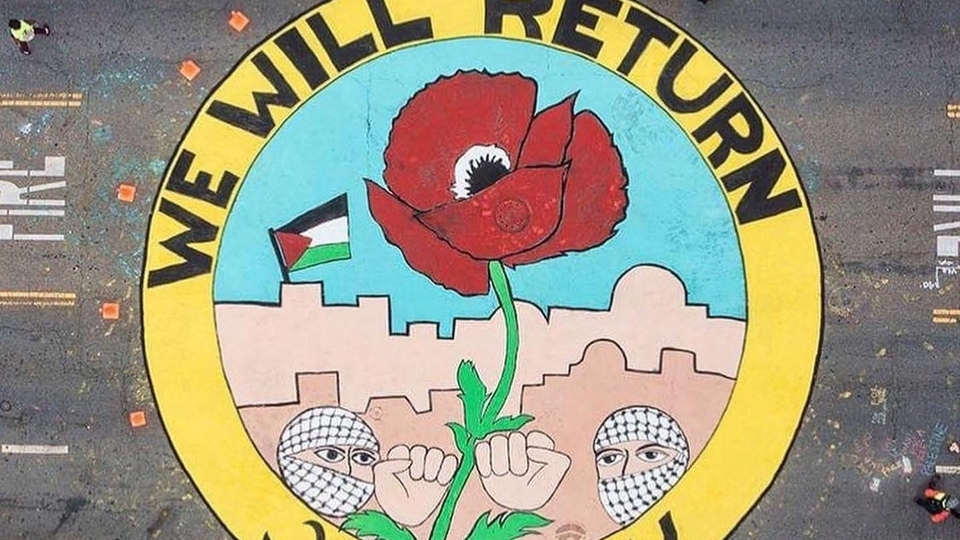
Dr. Salman Abu Sitta has no doubt that Palestine will inevitably be free.
Next, we need to know the people. We now have a record of Palestine before 1948. After that, they dispersed, but we managed to create a database for Palestinians all around the world. It’s not necessarily very accurate, but not wrong. This answers the second question: here is the land and here are the people of the land who are occupying their land. We studied Jewish immigration and Palestine. We know where they come from. Ashkenazis from Europe came before 1948 From 1950 to 1960, [Jews] came from Arab countries. From 1967, they came from Europe again. And from 1990, they came from Russia. We tried to locate where they are located. The Israeli Statistics Bureau has enough of this information so we asked a simple question: who's living on my land, who's living on your land? And we created that data. It's something indisputable because it's a fact. We found very startling results.
The Israelis list their localities; 954, say 1000, localities. This is misleading because only 5 percent of these localities house 90 percent of Jews and the other 95 localities are planted [with forests] in order to prevent the Palestinians from returning. The kibbutz and the army control 88 percent of Israel and the Israelis live in 12 percent or, in terms of kilometers, 1400 square kilometers. Jews are located basically in three areas: [the] Tel Aviv area, West Jerusalem, and Haifa. So I made a plan that we could return to our places. 472 Palestinian villages have practically no Jews today, they could return. As for the Jews who are in these areas, we can offer them three cantons like in Switzerland, and in these cantons they can have full cultural and religious freedom. From this point of view, the application of Resolution 194 is absolutely feasible. There is, of course, one condition which everybody knows that there could be no life and no solution with the existence of Zionism. And this is not unusual. In Germany, Nazism has been abolished. Same with apartheid in South Africa. Portuguese Goa was in the continent of India for 300 years, but being the foreign body in a homogeneously different one, it had no life. Same with Macau and Hong Kong in China. These are like [warts] in your body. They cannot be hidden.
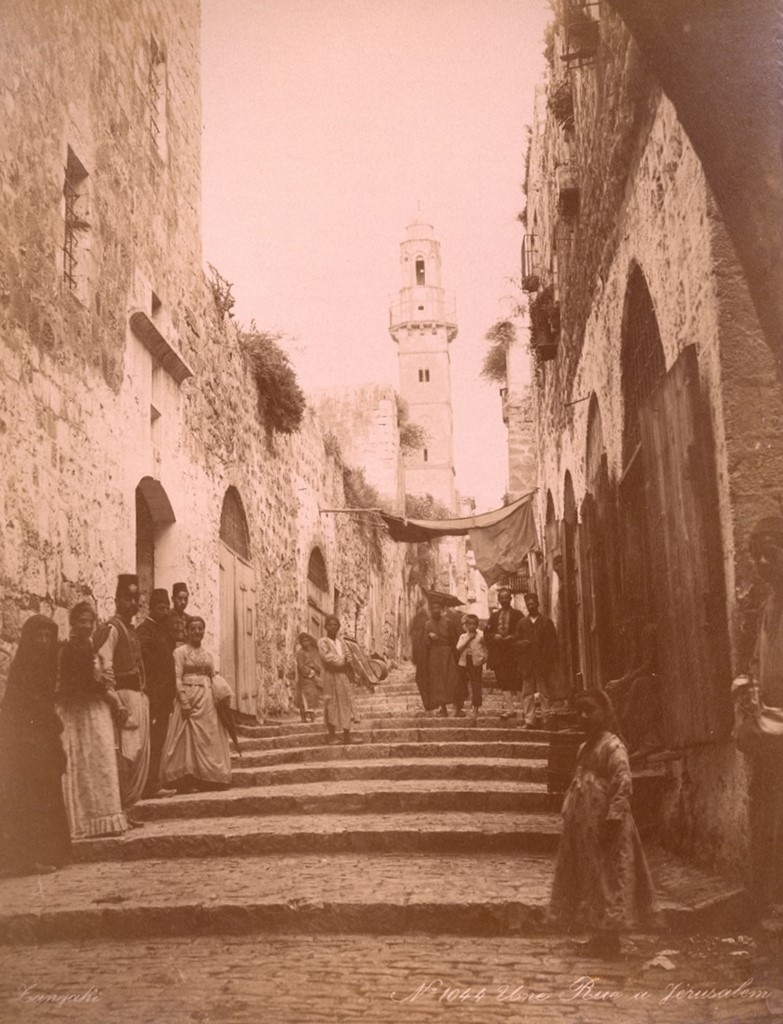
A street with people in al-Quds. E. W. Blatchford Collection, 1880-1900, American University of Beirut, Library Archives.
The condition for peace is that, firstly, human rights must be applied, which means everyone has the right to return to their property, and to have their freedom. Then, if people want to live under this umbrella, with no Zionism, no occupation, no apartheid, no war crimes, no genocide, they are like anybody else. When I give my talks in London, at university and other places, I say: why don't Jews live in Palestine like Jews live in London? They didn't kill English people, they didn't come and take their land? Why don't they live like that? Why don't they live in Palestine like they live in New York? They live by the law of the land.
I want to add one more thing regarding this knowledge that we created. We have proven [these facts about Palestine]. I repeat again, I stand to be corrected, but I have not seen any Israelis or Zionists dispute any of the facts represented. So if that's the case, why don't we plan for this? We know which refugees are from which village and they can return there. We charted roadmaps in which the distance from villages to camps is never more than 30 or 40 kilometers. Refugees in Lebanon can walk home, and in Gaza too. Literally, they can walk.
And by the way, just a footnote, when people in the West say hostages should be freed, I agree. I agree they should be freed. But there are 2.3 million Palestinians in Gaza held hostage for 76 years. 27,000 days. They come from 247 villages and cities. We have maps of them. They should be set free, they should return. And this is the answer we offer to people when they mention the kibbutz hostages. Some of the hostages in Gaza or held in Gaza are living on my own land. I was born in Ma’in. This is my father's land. So we have to take it over. When Palestinians return, they will find their villages destroyed. That’s alright because we have enough engineers and architects to recreate them.
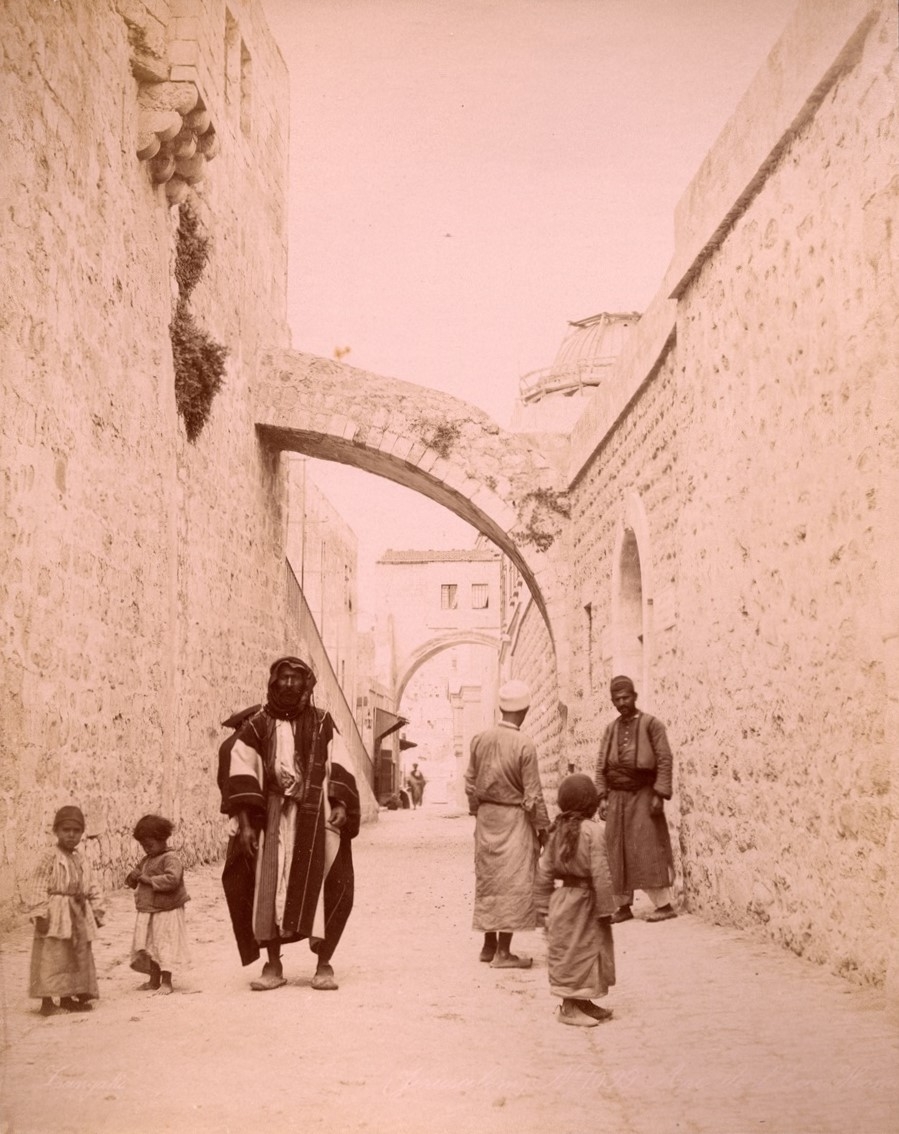
The Arch of Pilate on Via Dolorosa in al-Quds. E. W. Blatchford Collection, 1880-1900, American University of Beirut, Library Archives.
Eight years ago, we started a competition among young Palestinian architects for their graduation project. We said, “We'll give you one Palestinian village and your job is to redesign its reconstruction completely.” We have an inventory of 550 villages, and they pick one. They have to present a design for reconstruction of the village. So far, we have 12 universities participating every year. At the moment, a total of 270 young artists have participated. We have an international British jury. Every year, they decide on the top three designs. And every year, we reward the best design. These young people are marvelous; they already finished the complete reconstruction of 60 villages, divided by area from the North Mountain area to the coastline, and so on. This is done by young people who have never even seen Palestine. But they have ingenuity. They have the data, they have the heritage. The jury told me, “We are amazed! How could these young people redesign Palestinian villages with the same heritage, but with 10 times more people, and with new amenities like the internet and all that?”
So to recap the story, not only did they take our land, but they took the documentation. We can recover this documentation. Moreover, we can create from this documentation the map of the future. And I hope the young people will carry this on through your center and your ability to help them.
So to recap the story, not only did they take our land, but they took the documentation. We can recover this documentation. Moreover, we can create from this documentation the map of the future. And I hope the young people will carry this on through your center and your ability to help them.
Ghada Dimashk: Dr. Salman, we have the atlas here, the one you were talking about. Of course, you have seen the picture of the Israeli soldier sitting on the bench holding your atlas, I think mocking it. What would you say about this?
Dr. Salman Abu Sitta: That picture of the Israeli soldier is actually in the house of a relative of mine. When the soldier came to destroy and rob the house, he found this atlas. Now, I don't know what his motives were. First of all, he was curious about this atlas. I was hoping that when he read that atlas, he would say, “I am a foreigner, this is their country, and that's proof.” Now, whether he was mocking that or not isn’t clear. He might think, “it is your country, but we took it.” But if he has any inkling of intelligence, he would say, “I am taking the land of those people. And this is the proof.”
Ghada Dimashk: I have seen along your collection that you have a great interest in maps. And you have told me some stories about the way you have collected those maps. You told me that some of those maps are inaccessible. Only you have a photocopy of it and at the moment no one can access this map. It's really important for us as archivists to know how you got these maps. Have you ever used unofficial ways to retrieve some of the Palestinian archives?
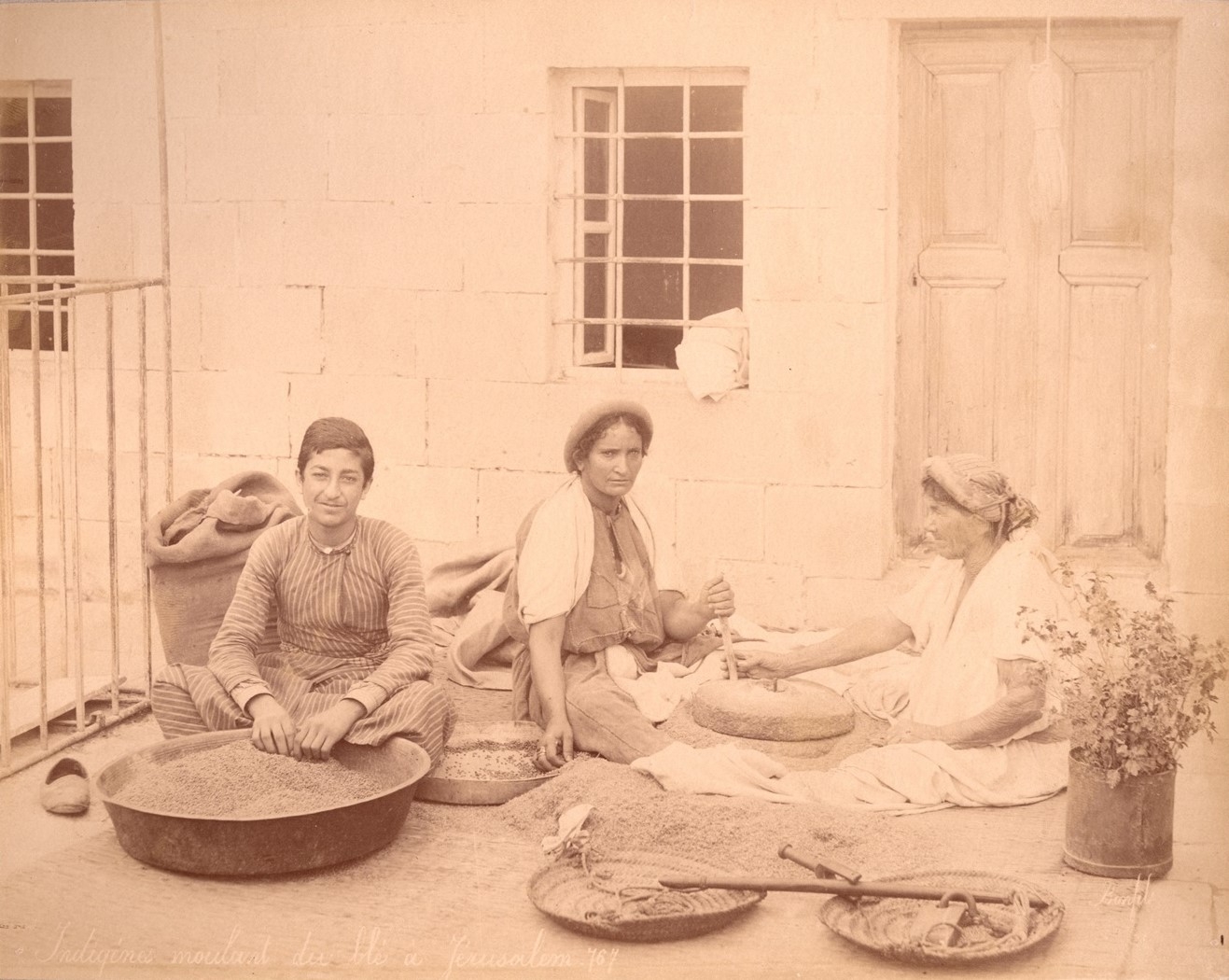
Two women, a boy, a pivotal grinding stone, wheat, and a scale with weights in al-Quds. E. W. Blatchford Collection, 1880-1900, American University of Beirut, Library Archives.
Dr. Salman Abu Sitta: Well, you're asking me to reveal something I would like to keep hidden. For one thing, when I started to collect these maps, I had to go about it like a reader. I'm not a government. I cannot order them from any government archives. And so the first thing I could try was going to all these libraries in many countries and be friendly with the librarian. First I take them to lunch, I give them presents, and that kind of thing.
One time in the United Nations library, when I was trying to get the armistice maps, to which the access was restricted, I connived with a friend who helped me. We invited the librarian to lunch and [while] he was away for an hour, we photocopied the maps. But there is something more interesting than that. I learned that the British, before they left, took many aerial photos of Palestine in 1945. And I read somewhere that there is this inventory of aerial photographs because the British had a sordid history in Palestine. They probably decided during the Second World War to take aerial photos of all of Palestine. I didn’t know where they were, but finally, I found them. It is in the library of the Royal Air Force, in a village somewhere in the west side of England. And when I tried to reach that, it said Joint Forces, which means that the Air Force can only deal and exchange information with similar Air Forces in other countries…
So I wrote a letter and I said, I need two photographs of someplace, which was my birthplace. There was no reply. And then someone said to remind them. I thought I’d tell them I am a planner and I wanted to know this piece of land as a planner, how it was and how it is. I just need four photographs of my land. Then I dialed a telephone number. A person, a corporal replied to me, and he asked, “Why do you want these?” I said, as a planner, I'm comparing the aerial photos from before until now. He said, “I'll call my superior officer.” I was waiting for probably 20 seconds or one minute, but it felt like an eternity. What is he going to say? He came back and he said, “Yes, but we need a letter from the country controlling this land, which is Israel, of course.” I said,“ Look, this has nothing to do with Israel. This is a British Aerial survey, you took it and you are the owner of this.”
Ghada Dimashk: You have faced a lot of obstacles, and you were sometimes not allowed to retrieve your own archive, your own history, about your own land.
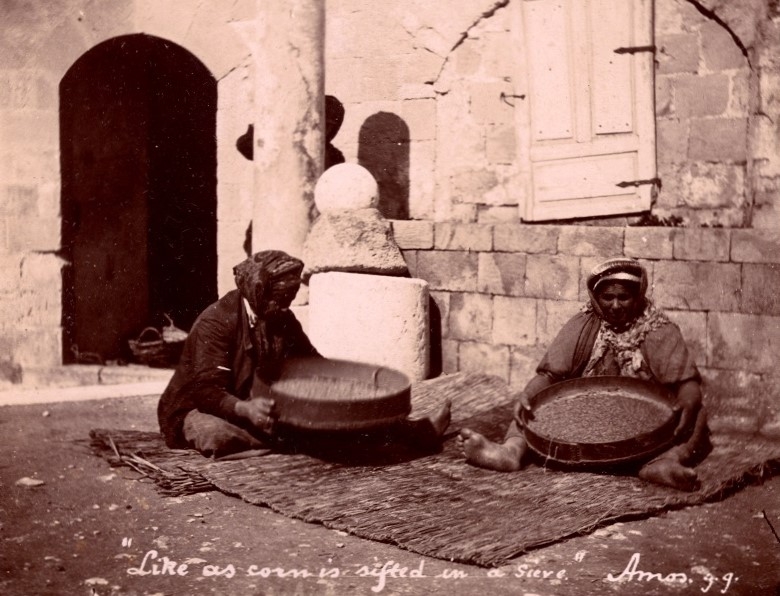
“Like as corn is sifted in a sieve”: two women sifting grain on [a] hasirah in al-Quds. E. W. Blatchford Collection, 1880-1900, American University of Beirut, Library Archives.
Dr. Salman Abu Sitta: Some people are helping. We got what is sufficient for us to know our situation. There is an imperative I must leave you with, especially you, as archivists. It's extremely important that you make this information known to be acted upon. The first step is to make it available for research. But more importantly, it should be the material for the decision makers. Now we have the International Court of Justice, we have international courts and criminal courts. All this material is very useful for them. For example, South Africa is taking Israel to the International Court of Justice. And the Israeli side says there is no intent for genocide, there is killing, but there is no intent of genocide. So I sent a file of documents to South Africa, showing that the intent is definitely in the Zionist history– real history – and this was never not the case. It's always the case. Though, I hope, through you, the researchers, young people, and even decision makers, make use of the data and not just hide it on shelves. Make use of that to create a better future.
Ghada Dimashk: There is a nice story you told me once. You bought a box, I think, from the British government. And you said you found a copy book inside that includes the names of villages that haven't been recorded. Who wrote those village names? I think he was a Syrian cartographer with the British government.
Dr. Salman Abu Sitta: That was the story of the Palestine Exploration Fund, when the British sent a survey to Palestine in 1871 and remained until 1877. They produced twelve volumes and maps. About twelve years ago, I went to this center called the Palestine Exploration Fund, established in 1865 and still exists today. I became a member there and said, “I want to know your records.” They let me but I had to pay. I paid an order to open their boxes, which had not been opened for 100 years.
“What do we collect all that data for? Just for history books? No, we must make it the foundation for the future.”
The surveyors who came to Palestine in 1877 returned with many papers and documents. They picked some of these documents to make maps, but they did not include all the information they brought back. So over a number of years, we produced The Atlas of Palestine 1871-1877, which is based on these but with the following corrections. First, we found 4,000 names not mentioned in the published British survey, so we added Arabic names in addition to the English ones. There was also an error in the geography because they didn't have satellites. We now have satellites. So we have this correction of the maps.
But what is surprising to me [is that] they refer to an “Arab scribe” who gave them the spelling of the Arabic names. Who is this Arab scribe? I found a master thesis at the University of Damascus about him. It turned out his name is Nu'man Al-Qasatli, a Syrian Christian from Damascus, recommended by the British consul to the team of the British surveyors, saying that he could help them with the Arabic language. It turned out that this man is a professional geographer, he wrote books about Palestine and about Damascus. And when I saw his handwriting, I compared it with the records found in England and it is the same handwriting. Notice the British racism: they call him an Arab scribe and, in fact, he is more qualified than some of their officers who were doing the surveying. So anyway, we told them that, like in so many ways in London, they are racist there.
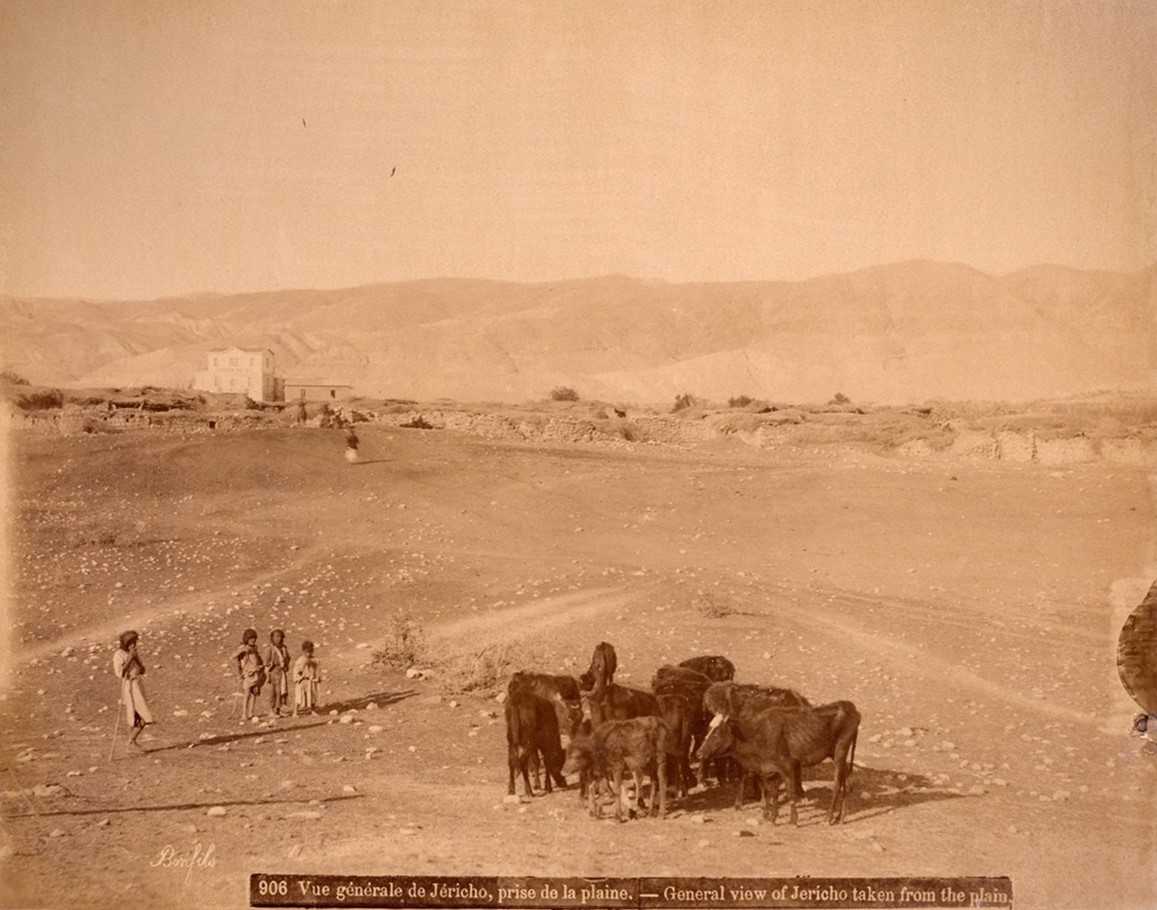
Jericho taken from the plain [Ariha]. E. W. Blatchford Collection, 1880-1900, American University of Beirut, Library Archives.
Dr. Jamila Ghaddar: I’d like to move to thinking about Gaza at this moment. To thinking about the archives, the people, the land.
Dr. Salman Abu Sitta: As someone who witnessed the Nakba in 1948, it was, of course, losing the whole country. However, the bloodshed in Gaza at the moment, a death toll of up to 100,000-110,000 people, is happening in the view of the whole world. In 1948, the story about our Nakba was so closed to the whole world but now everybody can see it with this little mobile phone. You can see everything. This is a big change. But what is so tragic is that although this picture is known to the whole world, although the International Court of Justice made sittings on that, and the International Criminal Court is scolding Netanyahu, in spite of the fact that the United Nations met three times, and their act was nullified by a U.S. veto, and so on, [it has not stopped]... It’s unbelievable to expect the world to stand for that.
We can also see, for over 220 days, F-16s, tanks, and Merkavas attacking people who don’t even have a single tank. And yet they have not surrendered and the Palestinians are causing them damage from time to time. No Arab country stood more than seven days in their wars, yet the Palestinians in Gaza have for 220 days. So the question is, is it only their sacrifice? Where are the millions of Arabs? Where are the millions of the Islamic world? Where are the people in Europe, that include Africans and Asians, who are on our side? Even in Germany (which is really the European branch of Israel).
I was invited to speak last April 2024 at a conference called Palestine Congress organized by Germans, including German Jews. Two minutes into my talk, 900 policemen came in, pulled the plug, and closed the whole conference. The Western countries which have been fighting us all these years in the First World War, in the Crusades, and even today are the same people who are attacking us all the time. They are the very same people. And they have failed all this time. In the year 1100, they failed. In the First World War, they failed. And now, they will fail. But at what price? Will they not learn? And I conclude with one point: no matter what happens, it's our responsibility to fight back. It's our responsibility to be steadfast. To do anything we can to never give up and never surrender. No matter how long it takes. This is the message I'd like to leave you with.
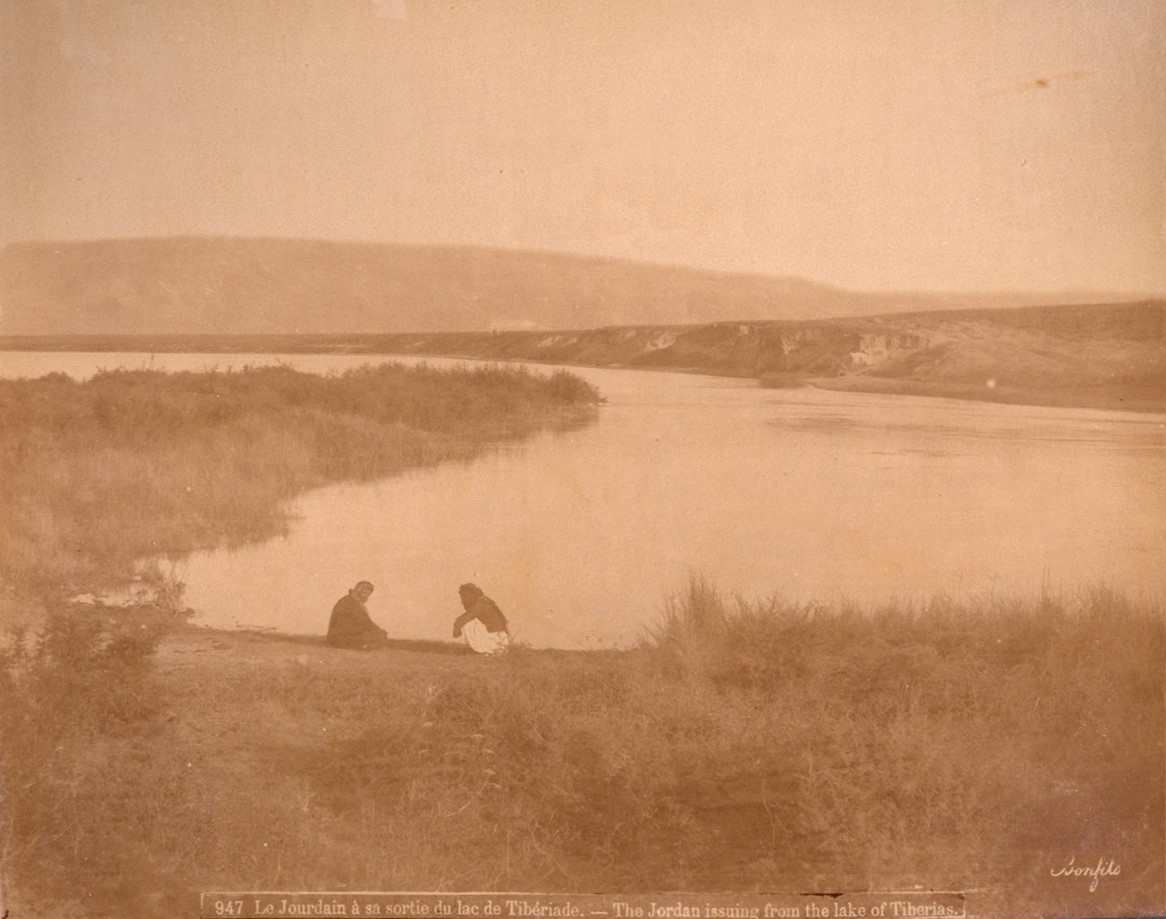
The Jordan River issuing from the Lake of Tiberias. E. W. Blatchford Collection, 1880-1900, American University of Beirut, Library Archives.
Call to Action
This talk included a statement titled, A Call to Archive Against Genocide: Archivists and Memory Workers in Solidarity with Palestine and Palestinian Colleagues, issued on June 4, 2024, by members of the “A Documentary Nakba: A Reading Group for Archival Liberation In & Beyond Palestine, who read it aloud.
The statement urgently and unequivocally calls on professional and academic archival, information and memory work colleagues, departments, institutions, and associations to:
Join the global movement for an immediate ceasefire, an end to the genocide on Gaza, and the liberation of Palestinian people everywhere.
Teach and learn about Palestine in our professional and academic training programs, educational institutions, curricula, and courses.
Center Palestinian experiences, perspectives, and voices in research and publications.
Correct predominantly reductive and racist cataloging, archiving, and metadata standards, frameworks, and tools pertaining to Palestinian geographies, people, communities, culture, history and materials.
Articulate new approaches that are informed by the work of Palestinian memory workers over the last century and beyond in key archival functions from acquisition and access to archival arrangement and description.
Make a concerted effort to gather and platform materials from Palestinian people, organisations, and communities in Palestine and the Shatat (Diaspora/Exile).
Support the return of stolen and displaced archives and records to Palestinian memory workers, institutions, and communities so that the Palestinian people can exercise self-determination over their own material worlds and story.
Boycott and divest from all academic, cultural and other Israeli institutions and organisations complicit through acts of commission or omission in the genocide, including those who refuse to speak out against Israeli war crimes and apartheid, those that receive funding from or collaborate with the Israeli state, and those who work with or have relationships with the Israeli military.
Support colleagues facing censure and institutional discipline for speaking up for Palestinian rights and against Israeli settler colonialism, apartheid, and occupation.
Mobilize knowledge, expertise, skills, resources, and privilege to counter the cultural dimensions of the Gaza genocide with the goal of preserving Palestinian history and memory and, most importantly, of stopping the genocide and settler colonialism perpetuated on the Palestinian people.
To archive against genocide.
